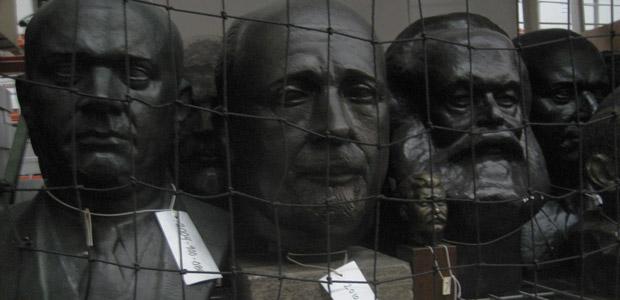California-based Cold War museum tries to preserve reminders of bygone era
Statues of high-level Communist officials sit on a shelf, part of the collection of the Wende Museum. They’re protected by an earthquake net. (Photo by Matthew Brunwasser.)
The Wende Museum offers the rich resources of its Los Angeles-based collection to visitors, scholars and exhibitions.
Almost 6,000 miles away from the divisive historical debates in Berlin, the Wende, which is a German word meaning turning point, hopes to preserve physical remnants of the Cold War for current and future generations to learn about its legacy.
An anonymous business park in sunny southern California is the unlikely home for this Cold War archive. It’s hard to imagine anywhere farther from the emotional debates, but Museum Director Justinian Jampol said that’s exactly the point.
“We wanted to have an archive away from it all, to be able to begin to preserve the materials for future generations,” Jampole said.
Europeans have long wanted to move on, so saving physical reminders of the unpleasant era isn’t a priority. Jampol said the museum sends scouts across Eastern Europe, looking for art and artifacts, including Communist-era statues about to be melted into scrap.
“That happened up until about a year ago,” Jampole said. “We have a 10 foot bronze sculpture, by Bondarenko, one of the very important Russian artists, that was still being melted down. And we got a call saying that this is available and we bought it for the price of the bronze plus five percent.”
Preserving the history of political, cultural and personal life, the Wende collects materials you won’t find in a typical historical archive.
“Ranging from furniture to blueprints to design material, artwork, menus, erotika, photo albums, journals, diaries,” Jampole explained.
The collection also includes pop music, including music from the Puhdys, one of East Germany’s most popular rock bands.
“This is dissident artwork, this is from perestroika in the 80s, critical of both Lenin and Stalin, when the process started of coming to terms with the past,” Jampole said as he showed off his collection. “In fact, this is one of my favorite pieces.”
One of the iconic pieces is a bust of Lenin which once stood in Leipzig, the Tahrir Square of East Europe during the tumultuous days of October 1989.
“It was painted to look like a clown using pink and green florescent paints,” Jampole said. “As the main figure of the ideology, if you could paint him like a clown, what next? Where does the state stand? In fact, one month later to the day, the Berlin wall collapsed.”
The main archive has about 75,000 items in its supermarket-sized facility. Many might say this enormous, neatly organized and cataloged collection of historical bric-a-brac is really just a warehouse full of old junk.
Scholars say it’s a precious resource of valuable information about daily life during the Cold War. But outside academia, the Wende has another life, trying to make the Cold War resonate with the public. It is a living museum after all.
The Wende organizes public events like one celebrating the anniversary of the Berlin Wall coming down. The Wende built a replica across Wilshire Boulevard — dividing Los Angeles for a night into west and east.
One current exhibition displays original surveillance equipment of the Stasi, or East German secret police. The idea is to provoke debate about contemporary surveillance of American citizens.
While Europeans try to put the Cold War behind them, the Wende is trying its best to give life to the memory and find today’s lessons from yesterday’s history.
